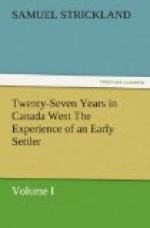In the month of May the settler should spring-burn three or four acres, and log them up for his spring-crops, such as potatoes and Indian-corn. The Indian-corn should be planted with the hoe in rows, three feet apart and thirty inches in the row. A pumpkin-seed or two should be sown in every second or third hole in each third row. The corn must be earthed or hilled up by drawing the mould close round the roots, and five or six inches up the stalks, which should be done when the plants are fifteen or sixteen inches high. No further cultivation is necessary until the time of cutting, except breaking off some shoots from the roots, if too many are thrown out.
Potatoes on the new land are also planted with the hoe, and in hills of about five thousand to the acre. A hole is scraped with the hoe, in which four or five sets, or a whole potato is dropped. The earth is then heaped over them in the form of a mole-hill, but somewhat larger. After the plants have appeared above the surface, a little more mould is drawn around them. Very large crops of potatoes are raised in this manner. Two hundred and fifty bushels per acre are no uncommon crop. I have assisted in raising double that quantity; but of late years, since the disease has been prevalent, but poor crops have been realized.
Both white turnips and swedes do well, and grow to a large size, particularly on new land: the roots must be either pitted or put in a root-house, or cellar, as the winter is too severe for them to remain unhoused.
The remainder of the fallow should be burnt off and logged up in July, the rail-cuts split into quarters and drawn off to the site of the fences, ready for splitting into rails. After the log-heaps are burnt, you should either spread the ashes or rake them while hot into heaps, if you intend to make potash,* with which, by the by, I should advise the new-comer to have nothing to do until he has made himself thoroughly acquainted with the process.
[* This article is very extensively made in nearly all the new settlements, and may be considered one of the staples of the country. The process is very simple; but great care must be taken in collecting the ashes clear of sand or dirt of any description. If your ashes are well saved and from good timber, ten acres should produce at least five barrels of potash, each barrel containing five hundred weight. Several things should be considered before the emigrant attempts the manufacture of this article. Firstly, his land should be well timbered with oak, elm, maple, and bass-wood. Secondly, it must have a stream of water, near which he may erect his works. And, lastly, it ought to be within reach of a market and a remunerating price, which, to pay the manufacturer, should not be less than twenty-five shillings, Halifax currency, per cwt.




